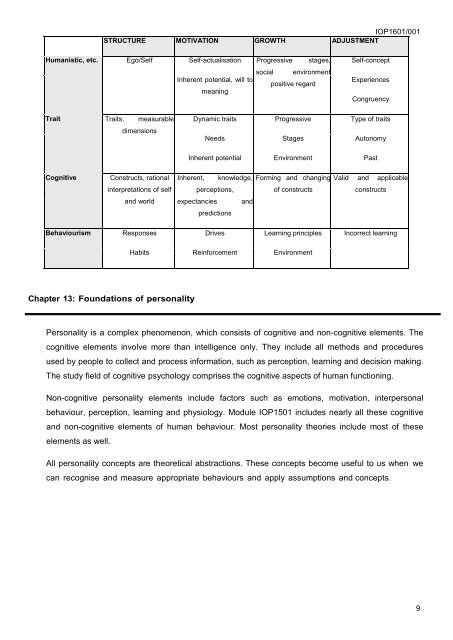IOP1601_MO001_3_2016_E
You also want an ePaper? Increase the reach of your titles
YUMPU automatically turns print PDFs into web optimized ePapers that Google loves.
<strong>IOP1601</strong>/001<br />
STRUCTURE MOTIVATION GROWTH ADJUSTMENT<br />
Humanistic, etc. Ego/Self Self-actualisation Progressive stages,<br />
social environment<br />
Inherent potential, will to<br />
positive regard<br />
meaning<br />
Self-concept<br />
Experiences<br />
Congruency<br />
Trait Traits, measurable<br />
Dynamic traits<br />
Progressive<br />
Type of traits<br />
dimensions<br />
Needs<br />
Stages<br />
Autonomy<br />
Inherent potential<br />
Environment<br />
Past<br />
Cognitive<br />
Constructs, rational<br />
interpretations of self<br />
and world<br />
Inherent, knowledge, Forming and changing Valid and applicable<br />
perceptions,<br />
of constructs<br />
constructs<br />
expectancies and<br />
predictions<br />
Behaviourism<br />
Responses<br />
Drives<br />
Learning principles<br />
Incorrect learning<br />
Habits<br />
Reinforcement<br />
Environment<br />
Chapter 13: Foundations of personality<br />
Personality is a complex phenomenon, which consists of cognitive and non-cognitive elements. The<br />
cognitive elements involve more than intelligence only. They include all methods and procedures<br />
used by people to collect and process information, such as perception, learning and decision making.<br />
The study field of cognitive psychology comprises the cognitive aspects of human functioning.<br />
Non-cognitive personality elements include factors such as emotions, motivation, interpersonal<br />
behaviour, perception, learning and physiology. Module IOP1501 includes nearly all these cognitive<br />
and non-cognitive elements of human behaviour. Most personality theories include most of these<br />
elements as well.<br />
All personality concepts are theoretical abstractions. These concepts become useful to us when we<br />
can recognise and measure appropriate behaviours and apply assumptions and concepts.<br />
9


